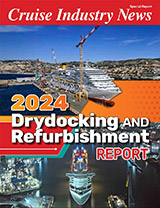Lloyd’s Register of Shipping (LR) has released its Global Marine Fuel Trends 2030 study that shows that heavy fuel oil (HFO) will continue to be the dominant fuel, with LNG developing to represent 11 percent of the total fuel consumption, and low sulfur fuel and hydrogen emerging as alternatives in certain scenarios.
The scenarios are: status quo, meaning that the world continues its current growth momentum with some boom and bust cycles over the next 20 years; there is a bigger shift of concern to resource limitations and environmental degradation focusing on sustainable development; or countries act more in their own national self-interest.
According to LR, the fuel mix for cargo ships will look less conventional by 2030. (The study did not mention cruise ships.) Pending different scenarios, LR predicted that HFO will represent from 47 percent of the overall fuel consumption in the status quo scenario to 66 percent in the competing nations scenario.
The declining share of heavy fuel oil will be offset by low-sulfur alternatives and by LNG, but this will happen differently for each ship type and scenario.
“I think the report underlines that any transition from a dependency on HFO will be an evolutionary process,” commented Project Leader Dimitris Argyros, LR’s lead environmental consultant. “LNG is forecast to grow from a very low base to a significant market share by 2030 – even if there is no major refit revolution – most of the LNG take-up will be in newbuilds. But it is important to note that an 11 percent share in 2030 is equivalent in volume to about 20 percent of the bunker market today.”



